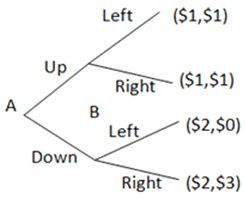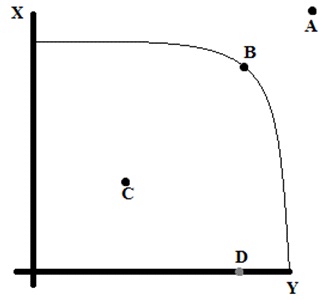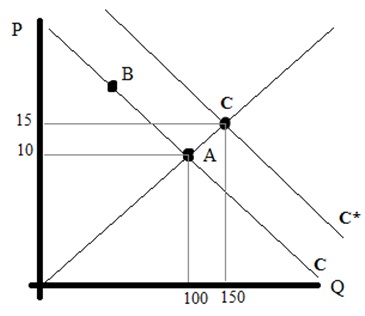Question 1: What is the Nash Equilibrium outcome of the game shown. Assume that each party is working for their own best interest:

A) (1, 1)
B) (2, 0)
C) (2, 3)
D) Not enough information
For questions 2-3 refer to the chart below. Assume each player works for their own best interests:

Question 2:Assume player A has first pick, what would they choose to maximize their outcome.
A) Cannot determine
B) A
C) B
D) C
Question 3: Assume player B has first pick, what would they choose to maximize their outcome:
A) Cannot determine
B) X
C) Y
D) Z
Question 4: What is the Nash equilibrium of the situation above:
A) (5,4)
B) (5,3)
C) (7,4)
D) (4,3)
For questions 5-6, refer to the graph below:

Question 5: Which of the points above is pareto efficient:
A) D
B) C
C) B
D) A
Question 6: Which of the point(s) above is/are pareto inefficient:
A) C and D
B) A and B
C) A
B) D
Question 7: Jan’s favorite food is popcorn, but she only has chips and water. Jennifer’s favorite food is chips, but she has popcorn and soda. Neither person likes the other’s drink. The following trade would be pareto efficient:
A) Water for soda
B) Popcorn for soda
C) Water for chips
D) Popcorn for chips
For questions 8-10 refer to the supply and demand graph illustrating a positive demand shock of the market for pizza:

Question 8: What is the equilibrium price and quantity for pizza after the positive demand shock:
A) $10, 100 units
B) $15, 150 units
C) $10, 150 units
D) $15, 100 units
Question 9: What is true about the consumer surplus in the market for pizza:
A) It has increased
B) It has decreased
C) It has remained the same
D) Not enough information
Question 10: Which of the following scenarios would create a positive demand shock as shown above:
A) The price of pizza ingredients decreased.
B) A drought created higher prices for the ingredients.
C) A news release reported that people who eat pizza live longer.
D) Eating pizza has gone out of style.